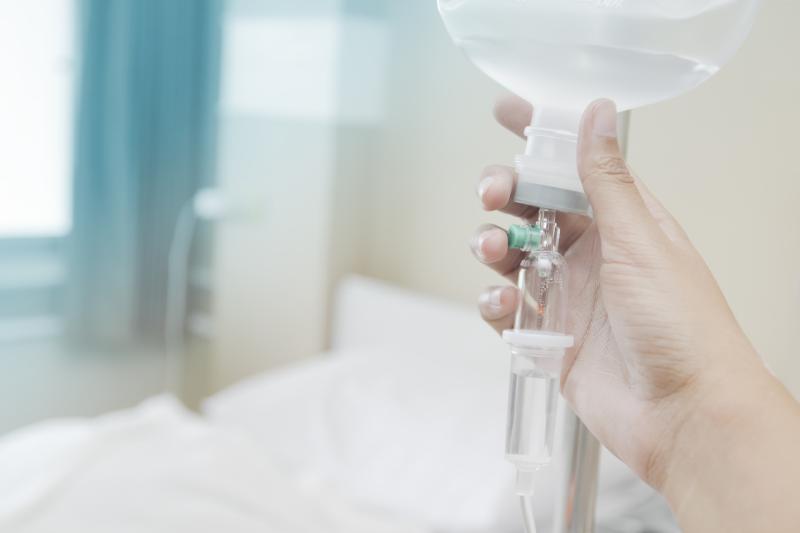Phase II trial of nipocalimab for Sjögren’s disease turns in promising results





The investigational monoclonal antibody nipocalimab helped reduce the intensity of Sjögren’s disease in adults in the phase II DAHLIAS trial.
At week 24, participants who received nipocalimab at 15 mg/kg achieved significantly greater reduction in Clinical EULAR Sjögren’s Syndrome Disease Activity Index (ESSDAI), the primary endpoint, compared with those who received placebo (mean change from baseline, –6.40 vs –3.74; p=0.002), according to first author Prof Jacques-Eric Gottenberg from the Strasbourg University Hospital in Strasbourg, France. [EULAR 2024, abstract LBA0010]
The treatment effect with nipocalimab occurred as early as week 4 and continued to increase throughout the 24-week treatment period, Gottenberg added.
Substantial improvements in the secondary endpoints were also observed at week 24, consistent with that of the primary endpoint. Compared with placebo, nipocalimab 15 mg/kg was associated with significantly greater decrease in the Physician Global Assessment of Disease Activity (between-group difference, –14.50, 90 percent confidence interval [CI], –20.81 to –8.19; p<0.001) and ESSDAI (between-group difference, –1.79, 90 percent CI, –2.94 to –0.63; p=0.012).
Significantly more patients on nipocalimab 15 mg/kg than on placebo achieved response as defined by the Sjögren’s Tool for Assessing Response* (between-group difference, 23.7 percent; p=0.017), Composite of Relevant Endpoints for Sjögren’s Syndrome** (between-group difference, 30.3 percent; p=0.001), and Disease Activity Level+ (between-group difference, 19.8 percent; p=0.046).
Notable trends of improvement with nipocalimab 15 mg/kg vs placebo were also seen for mouth drynesss, one of the most common symptoms of Sjögren’s disease. The corresponding proportion of patients with ≥50-percent improvement in unstimulated whole salivary flow rate was 32 percent vs 16 percent, respectively.
FcRn inhibition
Designed to block neonatal crystallizable fragment receptor (FcRn) to reduce the levels of circulating immunoglobulin G (IgG) antibodies and autoantibodies without causing broad immunosuppression, nipocalimab has demonstrated efficacy in the treatment of myasthenia gravis and haemolytic disease of the foetus and newborn. [Neurology 2024;102:e207937; Moise KJ, et al, WCFM 2023]
For Sjögren’s disease, nipocalimab treatment yielded reductions in the levels of total IgG and autoantibodies associated with the condition (ie, anti-Ro60 and anti-La IgG), in line with its mechanism of action.
Gottenberg highlighted a 77-percent maximum reduction in total IgG, as indicated in pharmacokinetic and pharmacodynamic simulations, in agreement with a minimum median reduction of 61 percent at week 24. “The magnitude of decrease in autoantibody levels anti-Ro60 and anti-La IgG was similar as that seen in total IgG levels.”
Safety and tolerability
“Nipocalimab was well-tolerated with no safety signals,” Gottenberg said.
Serious adverse events occurred in 7.5 percent of patients on nipocalimab and 5.4 percent of those on placebo. Infections and infestations were documented in 56.1 percent and 42.9 percent, while hypersensitivity reactions were reported in 12.1 percent and 5.4 percent, respectively.
Nipocalimab 15 mg/kg did not produce clinically meaningful effects on albumin (–6.9 percent), low-density lipoprotein cholesterol (6.9 percent), and total cholesterol (8.9 percent), according to Gottenberg. None of the patients died or experienced severe hypoalbuminaemia (<20 g/L) during the study.
The safety findings for nipocalimab, he added, were consistent with those reported in patients with myasthenia gravis, rheumatoid arthritis, and haemolytic disease of the foetus and newborn.
“[Overall,] these data establish the clinical benefits of reducing IgG autoantibody levels for the treatment of Sjögren’s disease … and support further clinical development, which is welcome news for the approximately 4 million people worldwide living with this chronic, debilitating disease,” Gottenberg said.
“Patients with Sjögren’s disease need approved advanced therapies that can help address the serious health consequences of the disease, and I am encouraged by these results and the positive impact on disease measures that are clinically meaningful,” he added.
DAHLIAS included 163 adult patients (median age 48.0 years, 92.6 percent female, 90.8 percent White) with moderately-to-severely active primary Sjögren’s disease (total Clinical ESSDAI] ≥6) who were seropositive for anti-Ro60 and/or -Ro52 IgG antibodies. These patients were randomly assigned to receive nipocalimab at 15 mg/kg (n=54) or 5 mg/kg (n=53) or placebo (n=56). Treatment was administered intravenously every 2 weeks through week 22 in addition to protocol-permitted background standard of care.
Results for 5 mg/kg nipocalimab were largely nonsignificant as compared with placebo.
*An index that includes all main Sjögren’s disease features, including systemic disease activity, patient-reported symptoms, tear gland item, salivary gland item, and serology
**A composite endpoint tool consisting of five complementary items, systemic disease activity, patient-reported symptoms, tear gland item, salivary gland item, and serology
+A reduction from baseline in disease activity level by at least 1 level in at least 1 Clinical ESSDAI domain (eg, articular, haematological, cutaneous, constitutional)